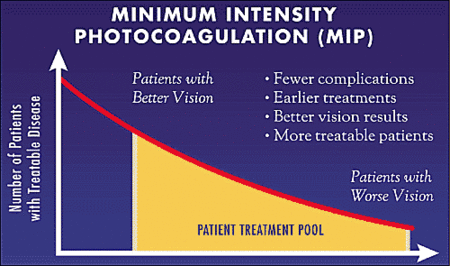Minimum-intensity photocoagulation a growth strategy for Iridex
The therapy, which uses smaller amounts of energy than traditional photocoagulation, could limit damage from laser burns.
MOUNTAIN VIEW, Calif. – Minimum-intensity photocoagulation (MIP) may offer a safe way to halt the progression of progressively degenerative disorders such as age-related macular degeneration (AMD) and diabetic retinopathy earlier in the course of the disease, thus preserving more of a patient’s vision. MIP may be less damaging to retinal tissues than traditional photocoagulation, according to officials at Iridex who have been developing the treatment concept with leading retina specialists.
“MIP represents a gentler way to administer laser therapy with the goal of achieving the therapeutic benefits while minimizing the nontherapeutic and functional damage,” said Theodore A. Boutacoff, President and CEO of Iridex Corporation.
“The contribution could be huge to society because we’re preventing the very severe vision loss associated with certain degenerative retinal diseases such as AMD. The contribution is significant to physicians because they could potentially provide better care to their patients and treat more patients. MIP is a key part of the company’s ophthalmic strategy and Iridex foresees that MIP will be the dominating laser approach in the future.”

Opportunities
According to Mr. Boutacoff, Iridex has been successful because the company’s management has been able to recognize important trends in the marketplace.
“We have been successful in identifying trends in applications and appropriately matching new technology with developing applications. We start by finding niches where this concept works and then hopefully expand to a broader use,” he said.
One trend that Iridex plans to aggressively pursue is the concept of MIP, where the patient is lightly treated with laser energy to prevent damage to the eye by the therapy itself.
“In MIP the typical laser application is so light that it is not seen by the physician,” Mr. Boutacoff said. “In conventional photocoagulation physicians have been delivering doses of laser energy to make ophthalmoscopic visible changes that indicate the natural transparency of the neuroretina has been thermally damaged to the point that the illumination light starts scattering.
“The actual mechanism of action of photocoagulation remains poorly understood, but there is a growing consensus that the damage to the neuroretina represents only a convenient end-point for the surgeon and may not be necessary for triggering the therapeutic benefits. The minimum dose necessary for therapeutic outcome in various retinal disorders is presently unknown, but reports from early studies using MIP protocols indicate that clinical resolution does not appear to require inner retina damage.”
Iridex is a pioneer in MIP protocols and believes this therapy will propel the company forward.
“We see a significant opportunity with this whole concept of minimum intensity photocoagulation that will alter the way photocoagulation is performed. This may take a number of years and there will be niches that will adopt this approach sooner than others,” Mr. Boutacoff said.
MIP may be compared to the whole minimally invasive surgical concept occurring in other ophthalmic applications. For example, people are looking at how small an incision is necessary to create an effect in cataract surgery.
MIP was developed because of the ex tent of nontherapeutic damage that occurs in traditional photocoagulation therapy.
“We’ve been working on the MIP approach for the last 8 years,” Mr. Boutacoff said. “MIP protocols have been developed to treat specific diseases such as transpupillary thermotherapy for the treatment of wet AMD, sub-threshold continuous-wave photocoagulation for the treatment of dry AMD and Micro Pulse photocoagulation for the treatment of diabetic retinopathy. All of these protocols follow the MIP concept of delivering the minimum laser dose proven to stimulate the therapeutic effect.”
Helping earlier
In general, the timing of a treatment option and when a physician chooses to intervene is determined by its risk-to-benefit ratio. A treatment option with high risks (ie a lot of damage is caused by intervention) will benefit fewer people since a physician will wait until further in the disease progression when vision is lost to treat.
Since MIP has fewer treatment complications (ie a lower risk-to-benefit ratio), it may be used earlier in the intervention process, thereby preserving more vision and benefiting more patients.
“We’re not claiming that physicians will be able to restore vision, but most of the MIP interventions allow preservation of vision while it’s there. If you’re preserving vision while it’s better, more patients are going to be interested and willing to be treated, so that’s going to bring more patients to the patient pool as well,” Mr. Boutacoff said.
For Your Information:References:
- Theodore A. Boutacoff can be reached at Iridex, 1212 Terra Bella Ave., Mountain View, CA 94043; (650) 940-4700; fax: (650) 940-4710; e-mail: tboutacoff@Iridex.com.
- Reichel E, Berrocal AM, et al. Transpupillary thermotherapy of occult subfoveal choroidal neovascularization in patients with age-related macular degeneration. Ophthalmology. 1999;106:1908-1914.
- Olk RJ et al. Therapeutic benefits of infrared (810-nm) diode laser macular grid photocoagulation in prophylactic treatment of nonexudative age-related macular degeneration. Ophthalmology. 1999;106: 2082-2090.
- Moorman CM, Hamilton AMP. Clinical Applications of the MicroPulse diode laser. Eye. 1999;13: 145-150.
